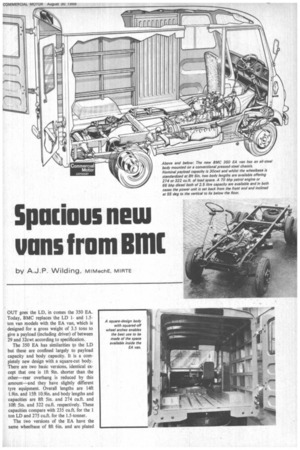Spacious new wins from Billt
Page 49

Page 50

If you've noticed an error in this article please click here to report it so we can fix it.
by A.J.P. Wilding, MIMechE, MIRTE
OUT goes the LD, in comes the 350 EA. Today, BMC replaces the LD 1and 1,5ton van models with the EA van, which is designed for a gross weight of 3.5 tons to give a payload (including driver) of between 29 and 32cwt according to specification.
The 350 EA has similarities to the LD but these are confined largely to payload capacity and body capacity. It is a completely new design with a square-cut body. There are two basic versions, identical except that one is 1ft 9in. shorter than the other—rear overhang is reduced by this amount—and they have slightly different tyre equipment. Overall lengths are 14ft 1.9in. and 15ft 10,9in. and body lengths and capacities are 8ft Sin. and 274 cu.ft. and 10ft Sin, and 322 cu.ft. respectively. These capacities compare with 235 cu.ft. for the 1 ton LD and 275 cu.ft. for the 1.5-tonner. for 3.5 tons gross. But while both have a 1.3-ton plated front axle, the 274 cult, van has a rear axle plated for 2.4 tons and the 322 cult. model, 2.7 tons.
To give free access from the driver's seat across the van in conjunction with forward control, the engine is inclined at 55 deg to the vertical (the top is moved over to the right-hand side), is set behind the front axle and located below the floorline. The radiator is at the front end of the chassis and a large-diameter duct runs between it and the fan surround (on the engine).
New engine
The EA is powered by a new BMC 2.5-litre four-cylinder engine which has been developed from the 20-year-old 2.2-litre BMC unit. Petrol and diesel versions are available and in both cases the bore diameter is increased to achieve the greater swept volume. Bore and stroke of the petrol are 3.34in. (85mm) and 4.38in. (111mm) respectively and for the diesel, 3.5in. (89mm) and 4.0in. (10I.6mm) respectively. Maximum-gross output of the petrol unit is 70 bhp (BS AU.141) at 3,500 rpm and maximum torque is 130 lb.ft. at 1,500 rpm. Comparable figures for the diesel are 66 bhp at 3,500 rpm and 114 lb.ft. at 2,000 rpm.
The engine drives through a 10in, clutch to a four-speed gearbox with synchromesh on three forward gears (not first). Ratios are 4.63, 2.69. 1.57 and 1 to 1, with reverse 5.93 to 1. The spiral-bevel rear axle has a ratio of 4.585 to 1.
The hydraulic brakes of the EA are fed by a tandem master cylinder with separate circuits for the front and rear. Two-leading-shoe units are employed at the front wheels with duo-servo units at the rear. Sizes are IOin. by 2.75in. all round with a total frictional area of 211 sq.in. The single-pull handbrake acts mechanically on the rear wheels.
Both versions of the model have 14in. wheels and tyres with twins at the rear but the tyre section on the 274 cu.ft. van is 7.00, and 7.50 on the 322 cu.ft. version. Steering is through a cam and peg box with a 20 to 1 ratio and steering wheel diameter is 16.5in. Suspension is by semi-elliptic springs with lever-arm dampers standard all round. A 12V positive-earth electrical system includes a 45 amp alternator as standard.
A lot of attention has been paid to facilities to make the best use of the space available inside the EA body. Rear-wheel arches are squared off to allow easy stacking of' goods around them; the distance across the floor between the arches is 3ft 7.3in. Overall width shows an increase of 6in. over the LD at 6ft 10in, and interior body height is also increased—to 5ft 8.6in.
Sliding doors
Sliding doors are fitted on the EA but the space taken up by the compartments into which they retract is kept to a minimum. The posts inside the van which extend from the door boxes to the rear are joined by horizontal pressings which provide useful lashing rails and the ply floor has longitudinal steel strips at intervals which extends life. When unladen the floor height of both versions is just under 2ft 6m. and the overall height is about 8ft 4in.
Improved trim
There are standard and de luxe versions of the EA, the main differences being chromium-plated front bumper and rear quarter bumpers on the de luxe as against a painted front bumper only on the standard. There is improved trim for the driver's seat in the de luxe, and a heater and demister unit is fitted, as also is a spare wheel, tyre and carrier, whereas these items are optional on the standard model.
The standard version of the EA with 274 cu.ft. body and petrol engine, costs £965. Specification of the 322 cu.ft. model adds £40 to the price (£1,005) and in both cases the diesel version costs £65 more. Price increase for the de luxe version is £50 in all cases. Optional extras listed include painting, which costs £17 lOs or £20 according to the body length and this represents particularly good value as even if a special exterior colour is needed, the cost of applying finishing coats to the outside is relatively low and a colour can be specified from the the range of five offered which allows the interior finish to be a match.




















































































